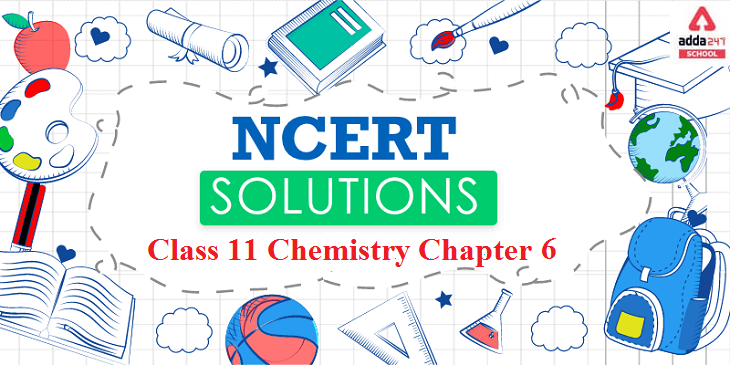Ncert Solutions For Class 11 Chemistry Chapter 11 Pdf Download
Adda247 provides NCERT Solutions for class 11 Chemistry Chapter 11. The NCERT Solutions provided here will enhance the concepts of the students, as well as suggest alternative methods to solve particular problems to the teachers.
Chemistry is much more than the language of Science. We aim to aid the students with answering the questions correctly using logical approach and methodology. The NCERT Solutions provide ample material to enable students to form a good base with the fundamentals of the subject.
Students who are looking for Class 11 Chemistry NCERT Solutions can refer to this article. Students will be provided detailed Class 11 Chemistry NCERT Solutions. Students can find here NCERT Solutions of Class 11 Chemistry PDF in Hindi and English medium.
Students of Class 11 must be through with Science NCERT Class 11 Chemistry Solutions in order to secure good marks in the board exams. These solutions will not only help the students to prepare for board exams but also prepare for competitive medical and engineering entrance exams.
Chemistry is an interesting subject but many of your students might find it confusing to understand. It can be a struggle for many of you.
Benefits of Solutions of NCERT class 11 Chemistry:
- NCERT Solutions for Class 11 is helpful to solve questions from other reference books too.
- NCERT Solutions for class 11 Chemistry will assist students to cross check answers and prepare for the exams in a strategic way.
The students can access the solutions anywhere while browsing web easily. The solutions are very precise and accurate.
NCERT Solutions of Chemistry Class 11 Chapter 11: The p-block Elements
Hydrogen is the most abundant in this universe, and thus any knowledge about this element allows one to explore numerous scientific phenomenon. Keeping this aspect in mind, CBSE has incorporated this topic into their curriculum so that keen students can learn the basic of this element.
Such a topic may seem challenging for students to decipher. In such a synopsis, they can rely on Hydrogen Class 11 Chemistry NCERT Solutions that provide comprehensive guidance on this topic with its eloquent explanation.
[sso_enhancement_lead_form_manual title=”Download Full PDF of Class 11 Chemistry Chapter 11 ” button =”Download Now” pdf =”/jobs/wp-content/uploads/2021/07/09021053/chapter-11-11th-class.pdf”]
The purpose of NCERT Solutions for Class 11 Chemistry Chapter 11, is help students understand the elements that are present in the p-block of the modern periodic table. Reason behind placing importance on this section is to understand how f and d electrons tend to make chemistry even more interesting. Proper analysis of this chapter will allow students to learn of general trends in modern chemistry.
With the help of the Class 11 p-block NCERT Solution, students can aim to score well in their 11th – grade exams. The chapter also goes on to explain the behaviour of different elements and their properties. Basic knowledge on this topic had been provided before, and this chapter aims at providing a more detailed analysis.
The p-block is the region of the periodic table that includes columns IIIA to column VIIIA and does not include helium. There are 35 p-block elements, all of which are in p orbital with valence electrons. The p-block elements are a group of very diverse elements with a wide range of properties.
The elements s-block and p-block are so-called because their valence electrons are either in an orbital s or p. These are often called Standard Components, in order to differentiate them from the sequence of transformation and internal transformation.
Uses of p-block Elements
A compound of boron called borax is used in the glass making industry and pottery.
Boron is also used in the soap or detergent industry.
Boron is used in aircrafts and bullet proof vests.
Boron is used in steel to increase its hardness.
S and p block elements are chemical elements found in the periodic table of elements. … The main difference between s and p block elements is that the valence electrons of the s block elements are in the s orbital whereas the valence electrons of the p block elements are in the p orbital. P- block includes elements from group 13 to18 . 16th G-chalcogens, 17th G-halogens, 18th G-noble gas. P-Block elements: Contains, metals, non-metals and metalloids. – Boron is a typical non-metal and the other members are metals. – Boron halides are considered to behave like Lewis acids. – Boric acid is a Lewis acid.
The general electronic configuration of p-block elements is ns2np1-6.
P-block metals have classic metal characteristics: they are shiny, they are good conductors of heat and electricity, and they lose electrons easily. Generally, these metals have high melting points and readily react with non-metals to form ionic compounds.
The metallic and non-metallic character of p-block elements varies as follows: Along the period the metallic character decreases, whereas non-metallic character increases. It is because on moving across the period, the atomic size decreases due to the increased nuclear charge and hence, ionization energy increases.
Important questions of NCERT Solutions for Chemistry Class 11 Chapter 11
Question: 1 Discuss the pattern of variation in the oxidation states of:
- B to Ti and
- C to Pb
Answer:
B to Tl- they belong to group 13 elements with electric configuration as ns2 np1. The atoms of these elements have 3 valence electrons, two in s subshell & one in p subshell,therefore all these elements show maximum of + 3 oxidation state. Boron shows only +3 oxidation state in its compound & other elements also show +1 oxidation state.The +1 oxidation state becomes more stable as we move down to the group from boron to thallium.The +1 oxidation state is more stable than +3 oxidation state because of inert pair effect .In the case of last element ,after the removal of one electron from p orbital, the remaining ns2 electrons behave like stable noble gases& donot take part in compound formation. This reluctance of the s electron pair to take part in chemical combination is called inert pair effect. The two electrons present in the s-shell are strongly attracted by the nucleus and do not participate in bonding. This inert pair effect becomes more and more prominent on moving down the group. Hence, Ga (+1) is unstable, In (+1) is fairly stable, and Tl (+1) is very stable.
| Group 13 elements | Oxidation state |
| B | +3 |
| Al | +3 |
| Ga, In, Tl | +1, +3 |
The stability of the +3 oxidation state decreases on moving down the group.
(ii) C to Pb- they belongs to group 14 in periodic table & are also called carbon family with electronic configuration of ns2 np2. Therefore, the most common oxidation state exhibited by them should be +4. However, the +2 oxidation state becomes more and more common on moving down the group. C and Si mostly show the +4 state. On moving down the group, the higher oxidation state becomes less stable. This is because of the inert pair effect. Thus, although Ge, Sn, and Pb show both the +2 and + 4 states, the stability of the lower oxidation state increases and that of the higher oxidation state decreases on moving down the group.
| Group 14 elements | Oxidation state |
| C | +4 |
| Si | +4 |
| Ge, Sn, Pb | +2, +4 |
Question: 2 How can you explain higher stability of BCl3 as compared to TiCl3?
Answer: Boron and thallium belong to group 13 of the periodic table. In this group, the +1 oxidation state becomes more stable on moving down the group. BCl3 is more stable than TlCl3 because the +3 oxidation state of B is more stable than the +3 oxidation state of Tl. In Tl, the +3 state is highly oxidising and it reverts back to the more stable +1 state.
Question: 3 Consider the compounds, BCl3 and CCl4. How will they behave with water? Justify.
Answer:
BCl3 is an electron deficient molecule. It easily accepts a pair of electron from water and hence, BCl3 undergoes Hydrolysis to form boric acid (H3BO3) and HCl.
BCl3 + 3H2O à H3BO3 + 3HCl .
CCl4 is an electron precise molecule having absence of d- orbitals in C-atom and hence, it neither accepts nor donates a pair of electrons. Thus, CCl4 doesn’t undergo hydrolysis in water.
Question: 4 Is boric acid a protic acid? Explain.
Answer:
Because it is not able to release H+ ions on its own. It receives OH− ions from water molecules to complete its octet and in turn releases H+ ions. It does not contain hydrogen ions so not a protonic acid but they can accept electrons from OH− so it is a Lewis acid. So, we can say that Boric acid is not a protic acid.
Question : 5 Explain what happens when boric acid is heated.
Answer:
On heating orthoboric acid (H3BO3) at 370K or above, it changes to metaboric acid (HBO2).
On further heating, this yields boric oxide B2O3.
H3BO3 heat 370K HBO2 heat red hot B2O3.
Question: 6 Write reactions justify amphoteric nature of aluminium.
Answer:
A substance is called amphoteric if it displays characteristics of both acids and bases. Aluminium dissolves in both acids and bases, showing amphoteric behaviour.
(i) 2AI(s) + 6HCI(aq) à 2AI3+(aq) + 6Cl-(aq) + 3H2(g)
(ii) 2AI(s) + 2NaOH(aq) + 6H2O(l) à 2Na+[Al(OH)4]-(aq) + 3H2(g)
Question: 7 What are electron deficient compounds? Are BCl3 and SiCl4 electron deficient species? Explain.
Answer:
In an electron-deficient compound, the octet of electrons is not complete, i.e., the central metal atom has an incomplete octet. Therefore, it needs electrons to complete its octet.
(i) BCl3
BCl3 is an appropriate example of an electron-deficient compound. B has 3 valence electrons. After forming three covalent bonds with chlorine, the number of electrons around it increases to 6. However, it is still short of two electrons to complete its octet.
(ii) SiCl4
The electronic configuration of silicon is ns2 np2 . This indicates that it has four valence electrons. After it forms four covalent bonds with four chlorine atoms, its electron count increases to eight. Thus, SiCl4 is not an electron-deficient compound.
Question:8 What is the state of hybridisation of carbon in:
a.) CO32-
b.) Diamond
c.) Graphite.
Answer:
a.) CO32-
C in CO32- is sp2 hybridised and is bonded to three oxygen atoms.
b.) Diamond
Each carbon in diamond is sp3 hybridised and is bound to four other carbon atoms.
c.) Graphite
Each carbon atom in graphite is sp2 hybridised and is bound to three other carbon atoms.
Question: 9 Rationalise the given statements and give chemical reactions:
- Lead (II) chloride reacts with Cl2 to give PbCl4.
- Lead (IV) chloride is highly unstable towards heat.
- Lead is known not to form an iodide, PbI4.
Answer:
(a) Lead belongs to group 14 of the periodic table. The two oxidation states displayed by this group is +2 and +4. On moving down the group, the +2 oxidation state becomes more stable and the +4 oxidation state becomes less stable. This is because of the inert pair effect. Hence, PbCl4 is much less stable than PbCl2. However, the formation of PbCl4 takes place when chlorine gas is bubbled through a saturated solution of PlCl2.
PbCl 2(s) + Cl2(g) à PbCl4(l)
(b) On moving down group IV, the higher oxidation state becomes unstable because of the inert pair effect. Pb(IV) is highly unstable and when heated, it reduces to Pb(II).
PbCl4(l) à PbCl 2(s) + Cl2(g)
(c) Lead is known not to form PbI4. Pb (+4) is oxidising in nature and I- is reducing in nature. A combination of Pb(IV) and iodide ion is not stable. Iodide ion is strongly reducing in nature. Pb(IV) oxidises I- to I2and itself gets reduced to Pb(II).
Pbl4 à Pbl 2 + l2
Question: 12 Explain the difference in properties of diamond and graphite on the basis of their structures.
Answer:
| Diamond | Graphite |
| It has a crystalline lattice. | It has a layered structure. |
| In diamond, each carbon atom is sp3 hybridised and is bonded to four other carbon atoms through a sigma bond. | In graphite, each carbon atom is sp2 hybridised and is bonded to three other carbon atoms through a sigma bond. The fourth electron forms a II bond. |
| It is made up of tetrahedral unit. | It has a planar geometry. |
| The C-C bond length in diamond is 154 pm. | The C-C bond length in graphite is 141.5 pm. |
| It has a rigid covalent bond network which is difficult to break. | It is quite soft and its layers can be separated easily. So it shows lubricating property. |
| It acts as an electrical insulator. | It is good conductor of electricity. |
Question: 13 Give reasons:
i.) Conc. HNO3 can be transported in aluminium container.
ii.) A mixture of dilute NaOH and aluminium pieces is used to open drain.
iii.) Graphite is used as lubricant.
iv.) Diamond is used as an abrasive.
v.) Aluminium alloys are used to make aircraft body.
vi.) Aluminium utensils should not be kept in water overnight.
vii.) Aluminium wire is used to make transmission cables.
Answer:
(i) Concentrated HNO3 can be stored and transported in aluminium containers as it reacts with aluminium to form a thin protective oxide layer on the aluminium surface. This oxide layer renders aluminium passive.
(ii) Sodium hydroxide and aluminium react to form sodium tetrahydroxoaluminate(III) and hydrogen gas. The pressure of the produced hydrogen gas is used to open blocked drains.
2Al + 2NaOH + 6H2O → 2Na+[Al(OH)4]- + 3H2
(iii) Graphite has a layered structure and different layers of graphite are bonded to each other by weak van der Waals’ forces. These layers can slide over each other. Graphite is soft and slippery. Therefore, graphite can be used as a lubricant.
(iv) In diamond, carbon is sp3 hybridised. Each carbon atom is bonded to four other carbon atoms with the help of strong covalent bonds. These covalent bonds are present throughout the surface, giving it a
very rigid 3-D structure. It is very difficult to break this extended covalent bonding and for this reason, diamond is the hardest substance known. Thus, it is used as an abrasive and for cutting tools.
(v) Aluminium has a high tensile strength and is very light in weight. It can also be alloyed with various metals such as Cu, Mn, Mg, Si, and Zn. It is very malleable and ductile. Therefore, it is used in making aircraft bodies.
(vi) The oxygen present in water reacts with aluminium to form a thin layer of aluminium oxide. This layer prevents aluminium from further reaction. However, when water is kept in an aluminium vessel for long periods of time, some amount of aluminium oxide may dissolve in water. As aluminium ions are harmful, water should not be stored in aluminium vessels overnight.
(vii) Silver, copper, and aluminium are among the best conductors of electricity. Silver is an expensive metal and silver wires are very expensive. Copper is quite expensive and is also very heavy. Aluminium is a very ductile metal. Thus, aluminium is used in making wires for electrical conduction.
Frequently asked questions on NCERT Solutions of chemistry Class 11 Chapter 11
- Why should I Refer to NCERT Solutions for Class 11 Chemistry Chapter 11?
Ans. If a student wishes to score well in their examinations, then referring to these solutions would be a smart choice. The reason behind that would be fact that these solutions are constructed to help students comprehend the concept behind the chapter a bit better. Questions present within this solution also follow an examination format to help students be better prepared to score good grades.
If a student wishes to finish their lesson plan a bit faster, then they may choose to opt for these solutions. They help enhance the student’s ability to comprehend the casis of the chapter.
- What are the important topics of p-block elements?
Ans. Important Topics
- Electronic Configuration
- Metallic Character
- Atomic Radii
- Ionization Enthalpy
- Electronegativity
- Melting and Boiling Points
- Oxidation States
- Colour









 NEET UG 2026 Registration: NTA releases ...
NEET UG 2026 Registration: NTA releases ...
 CUET UG 2026 Online Registration Started...
CUET UG 2026 Online Registration Started...
 CUET 2026 Free Batches Launched by CUET ...
CUET 2026 Free Batches Launched by CUET ...














